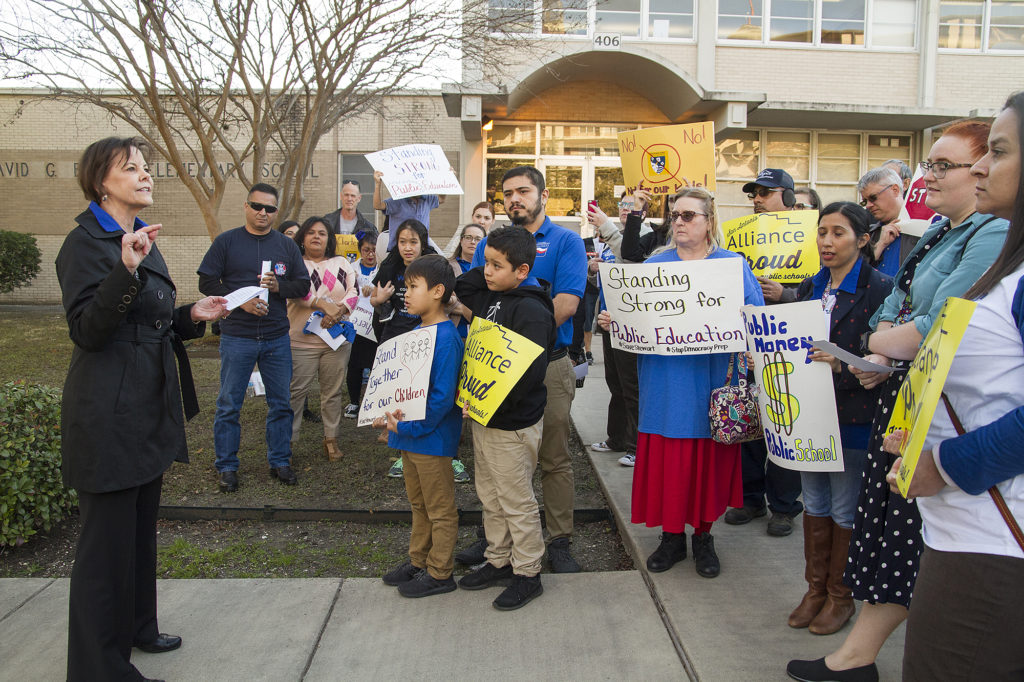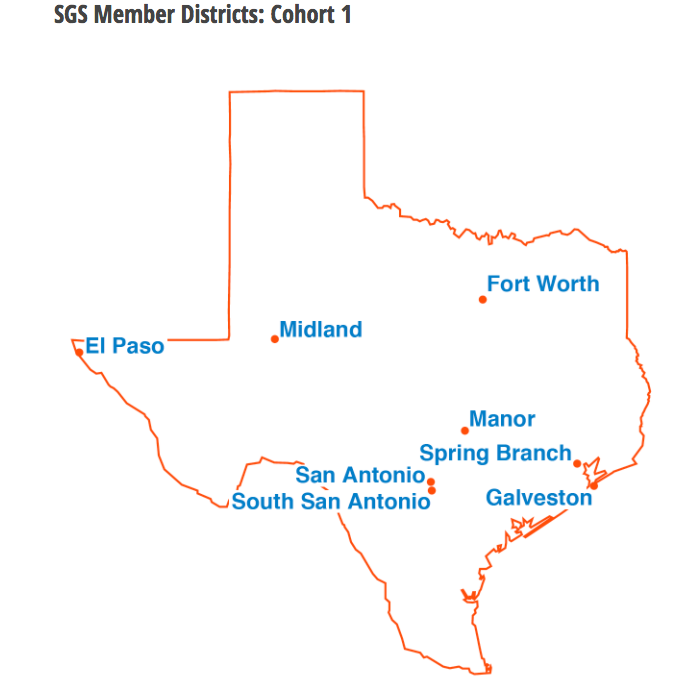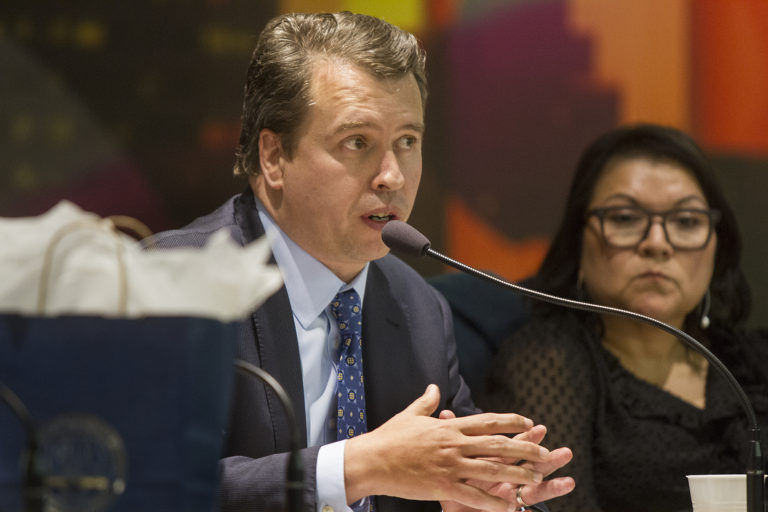Note from SA Charter Moms: We are proud to share guest posts from hallmonitor covering San Antonio’s public schools.
In a recent candidate forum with the advocacy group TX Charter Revolution, Matt Beebe, who hopes to take the seat vacated by retiring public school champion and Texas Speaker of the House Joe Straus, characterized the relationship between charter networks and traditional school systems as heading toward an unfortunate “us and them” mentality. He characterized the Bexar County public schools Go Public campaign as “a pretty direct jab at any parent or any family or any charter school teacher that is making a different choice.”
His run-off opponent Steve Allison disagreed. He saw great promise in the willingness of school districts to create choice programs like magnets, special schools, and career training programs.
“It’d be wonderful if we could have a system going forward where we’re all together,” Allison said.
Well, we do. It’s even called a “System of Great Schools” and two local districts, San Antonio ISD and South San Antonio ISD, are using it to address declining enrollment and underperformance, which last week led to 163 layoffs in SAISD. Which led to an angry crowd using words like “ruthless,” “heartless,” “disgusting,” “despicable,” “inhumane,” and “disturbing” at Monday night’s board meeting.
So we’re all getting together . . . but everyone is not getting along.

San Antonio Alliance of Teachers and Support Personnel President Shelly Potter addresses members of the San Antonio Alliance of Teachers Support and Personnel, Stewart Elementary parents and staff at a rally outside Burnet Elementary before the school board votes on whether to move forward with a partnership between Stewart Elementary School and Democracy Prep Public Schools, Monday, Jan. 22, 2018. Photo by Alma Hernandez for Folo Media
In fact, the very term “System of Great Schools” has recently been drug through the streets of SAISD as though it were the district’s dirty little secret, rather than a showcase initiative of the Texas Education Agency. Whether or not you agree with the approach to school governance, it’s no secret.
And the state is excited about the things they are seeing in SAISD, superintendent Pedro Martinez said. “They appreciate the fact that we’re willing to think out of the box.”
What Is a System of Great Schools?
In 2017, the TEA began offering technical support for districts pursuing the System of Great Schools model, which includes closing underperforming schools, increasing school choice options and access to those options, and increasing campus autonomy.
How individual districts interpret and apply those principles may look different, which is the point. Mentors provided by the state can help guide the System of Great Schools districts on how to select new school models, including creating their own internal charter schools (like CAST Tech and Young Women’s Leadership Academy) or partnering with existing networks (like Democracy Prep).
“One of the main goals of the System of Great Schools is to teach school districts how to become high quality school authorizers,” SAISD Director of Legislative and Strategic Affairs Seth Rau said. “It’s not even explicitly about charter schools, it’s about autonomous schools.”
Every school is different, proponents argue, which means that centralized governance of a large district is likely to miss the boat on some campuses. The system operates on the belief that autonomous schools are better equipped to serve students’ needs.

Texas Education Agency map
The first cohort of districts to participate in the initiative includes SAISD, SSISD, El Paso ISD, Manor ISD, Spring Branch ISD, Galveston ISD, Fort Worth ISD, and Midland ISD. These districts also have preferential access to grants. SAISD recently received a $1.9 million grant from TEA to redesign Page Middle School (instructionally, not architecturally).
“We definitely have the ability to help our schools and improve, but it takes a lot of resources,” SAISD superintendent Pedro Martinez told The Hall Monitor.
Troubled Systems
Relatively small South San ISD will start by magnetizing its three middle schools to create career-focused “academies,” and using an early college program to give students more choices at its only high school.
South San is overcoming its own set of problems. Declining enrollment will lead to a $6.6 million budget shortfall next year, and the school board has only recently emerged from state oversight after years of infighting and dysfunction. Even with this, none of the district’s schools have fallen short of state accountability standards.
At a recent town hall meeting, Superintendent Abelardo Saavedra attributed the declining enrollment to lack of quality housing in the district. He said that the school choice initiative was an effort to recoup some of those losses. Parents and students at the town hall expressed a range of feelings on the initiative, from full support to staunch opposition.
In significantly larger SAISD, the move toward a System of Great Schools has carried many of the same themes on a significantly larger scale.
SAISD covers three of San Antonio’s poorest zip codes. In 2017, 18 of its 90 campuses failed to meet State standards, and one school board member was arrested in an FBI federal wire fraud investigation. The board has recovered, and is moving in lockstep with the administration, but the district is still hemorrhaging students, as it has been for years. Declining enrollment will result in a projected $31 million budget cut for the coming fiscal year.
At its May 14 meeting, the San Antonio ISD voted unanimously to move forward with a 163-person reduction in force along with other cost saving measures. The move drew the biggest union turnout yet, with 60 people signed up to be heard, including some of the 132 teachers given the option to resign ahead of termination. Using the word “tense” to describe the atmosphere would be an understatement.
The district has lost a net total of 1,803 students since last year, the vast majority of them to charter schools like IDEA Public Schools, KIPP, and Jubilee Academy. The number would be larger, Martinez said at a press conference before the meeting, if it were not for the district’s burgeoning menu of its own special schools.

SAISD Superintendent Pedro Martinez at a school board meeting Monday, Jan. 22, 2018, where a vote was taken to move forward with a partnership with Democracy Prep Public School to takeover Stewart Elementary starting in the fall. Photo by Alma Hernandez for Folo Media.
“I needed to show the community that we could create quality options,” Martinez told The Hall Monitor.
A handful of those parents spoke up at the board meeting, saying that, indeed, choice programs and schools had brought them into the district.
The district has been rolling out specialized schools like Young Women’s Leadership Academy and the Advanced Learning Academy for around ten years, beginning with Travis Early College High School. These are district schools without attendance zones, and they attract highly motivated students. Currently the district’s specialized schools have a combined total of nearly 2,000 students on the waiting lists, Martinez said.
“We’re starting to bring back families,” he said, “But that doesn’t solve my problem of low performing students.”
The specialized schools have done very well, but they have done little for the students still attending comprehensive high schools. Magnet programs are in place at SAISD’s comprehensive high schools, but, again, these kinds of magnets and special tracks can bring the disparities to a campus level. It’s a benefit for the kids who participate, and invisible to the kids who don’t. The district needs high quality seats for every student, Martinez said, and the System of Great Schools is how he intends to create them. (Read: don’t change the channel.)
What about the Not-So-Great-Schools in the System?
The System of Great Schools recommends closing underperforming schools, which isn’t unfamiliar to SAISD. Over the past five years, SAISD closed six schools where enrollment fell too low. Some of those campuses have been repurposed for the specialized schools.
More neighborhood schools could have been on the chopping block after years of failing to meet state standards but for 2017’s Senate Bill 1882. This bill offers a two-year reprieve from state sanction for schools coming under the control of a nonprofit, state entity (like a university), or charter network.
In both the System of Great Schools and SB 1882, the state cares less about that technicality of whether the school is run by a charter network, a university, or a nonprofit, Rau explained, and more about the partner’s track record of student success.
SAISD cares more about a partner’s willingness to prioritize neighborhood students in enrollment. Charter networks have to give up whatever advantage they would have derived from having families self-select for increased rigor, behavioral standards, and school design.
Martinez is critical of charter networks who, he says, don’t serve the range of students his district serves.
“Kids that don’t fit (the independent charter network’s) mold, they come right back to us,” Martinez said, “I would never allow people to treat our children that way.”
Such partners were hard to find under SB 1882, Martinez has said. In the end, Democracy Prep and Relay Lab Schools were two of only a few partners who (1) agreed to his terms and (2) the state would accept.
“We’re not going to work with somebody who doesn’t have similar values to us,” Martinez said.
The district’s union, the San Antonio Alliance of Teacher and Support Personnel, disputes this assessment of the situation. The Alliance has claimed that the district prioritized charter partners, and did not consider partnerships with universities or other viable options.
The Alliance has spoken up at nearly every board meeting since the partnership with Democracy Prep, which will operate Stewart Elementary School, was announced in January. They’ve had plenty to speak about as the district announced similar partnerships with Relay Lab Schools at Storm and Ogden Elementary Schools, and Texans Can Academies for a school-within-a-school at Highlands High School.
Alliance members have also taken to blasting the superintendent and the board on social media, and someone has been pasting signs around the district accusing Martinez of selling out the district. Alliance members filed a grievance citing a lack of transparency, a filed a lawsuit claiming that the district did not meet the “community consultation” provision of SB 1882.
The Alliance filed the lawsuit after it obtained emails between district officials and Democracy Prep, showing that the discussion between the district and the charter network had been going on for months before the issue was brought to the public—less than a week before the board vote to move forward with the partnership. While the two sides have differing opinions on how the community should have been involved, it remains to be seen if the district violated any rules, as the Alliance claims it did.
Until then, the furor on social media continues to build—which may be the point, considering the board is an elected body. At the increasingly raucous board meetings, members of the Alliance and their families have begun to threaten to run, campaign, and advocate against school board members up for re-election in coming years. (Though, for the record, the board members don’t seem particularly intimidated by this, as unanimous vote after unanimous vote rolls through.)
In response to the social media buzz after the Alliance obtained district emails, Martinez sent out an email of his own to district staff.
“I want to be clear on this: We have had and will continue to have discussions with parties about possible collaboration and partnerships that would benefit our district and students. I have been open about this since I came here. I welcome these discussions,” Martinez wrote. “These partnerships with external charters or networks will be a small percent of our schools. And only as a last resort would this involve managing an existing SAISD school in order to avoid closure.”
Martinez points to his record of traditional school turnarounds using district staff at Gates Elementary School and Davis Middle School. Stewart Elementary, where Democracy Prep will operate, did not respond to previous efforts to use a strong principal and university partnerships, he said, but he did try those options before reaching out to Democracy Prep.
“Judge me by my actions,” he told The Hall Monitor.
Call it What You Like . . .
While it’s true that SB 1882 and the System of Great Schools do not mandate charter partnerships, they definitely make them easier. A bulletin sent out to the Systems of Great Schools cohort described SB 1882 as a mechanism to engage charter network partners and create internal charters.
In 2017, the Laura and John Arnold Foundation gave a two-year, $85,000 grant to the TEA through Education Service Center Region XIII “to support the Texas Education Agency’s System of Great Schools Network, a program for districts interested in the portfolio model of school governance.”
SAISD’s System of Great Schools advisor, Paul Pastorek, was Louisiana’s Superintendent of Education post-Katrina, when the state embarked on a massive charter partnership initiative. He is currently the chair of the board for the National Alliance for Public Charter Schools.
Joe Siedlecki, an advocate for the “portfolio model,” serves as associate commissioner of school improvement and advisor to the division of TEA that oversees the System of Great Schools initiative.
The portfolio model—as in Denver, New Orleans, and Indianapolis—brings charter networks into a district. The district acts as a school authorizer, leaving curriculum, staff, and school calendars to each campus. The district may still provide transportation, meal services, and other universal needs, but even the systems that use the model differ in exactly how they manage the balance of campus and central office administration.
“We believe that parents should have a fair opportunity to find a best fit school for their children,” Siedlecki wrote in a blog post for the Center on Reinventing Public Education. That “we” was the Quality School Options initiative of the Michael and Susan Dell Foundation, his previous gig.
Martinez insists that SAISD is not pursuing a portfolio model, despite the involvement of foundations like the Walton Foundation, which gave facility funds to CAST Tech. One of the principal differences in SAISD would be the centralized control of enrollment. Because Martinez does not want the schools to be able to pick and choose which students they serve, the district will keep a tighter reign than in classic portfolio models. “We’re asking those funders to look at a different way of doing things,” he said.
Not just funders. Martinez is asking teachers and parents to consider a different way of doing things as well. Not to do so, he says, would be negligent, because there are families with nowhere else to go. While the Alliance has vowed to fight his methods, and him, every step of the way, Martinez is convinced that parents are responding.
“The parents really don’t want to deal with this drama. They want what’s best for their child.”
Originally published as “In becoming a “System of Great Schools,” SAISD is fighting for its life,” Hall Monitor, May 15, 2018
Read more:
- “[Hall Monitor] Bonham Academy, San Antonio’s Dual Language Darling, Fears for Its Future,” San Antonio Charter Moms, May 31, 2018
- “[Hall Monitor] Meet Relay Lab Schools, SAISD’s Third Partner Under SB 1882,” San Antonio Charter Moms, May 12, 2018
- “[Hall Monitor] Texans Can Academies at Highlands High School: Another Charter Operator to Set Up Shop in San Antonio ISD,” San Antonio Charter Moms, April 27, 2018
- “[Hall Monitor] Stewart Welcomes Democracy Prep to the Neighborhood With Lots of Questions,” San Antonio Charter Moms, April 11, 2018